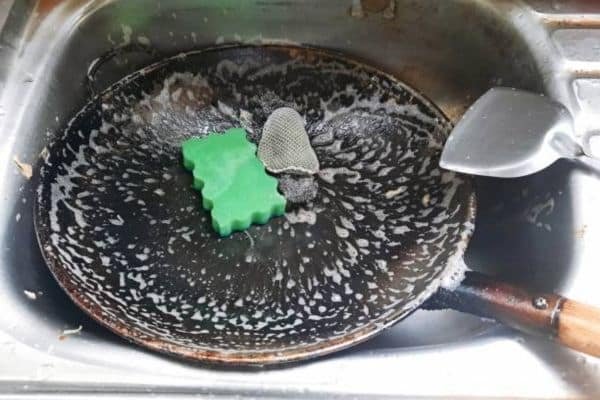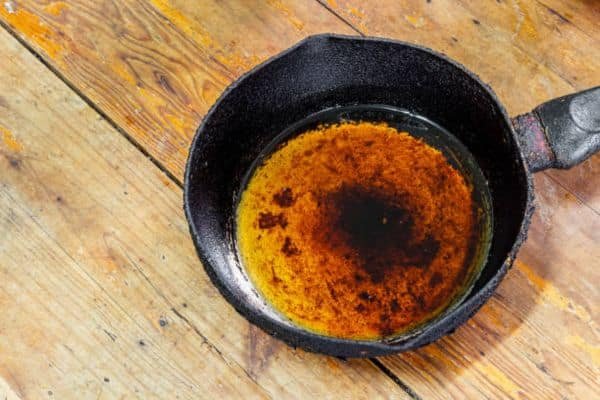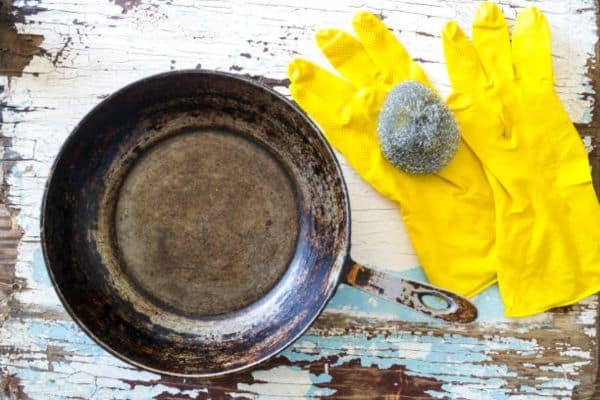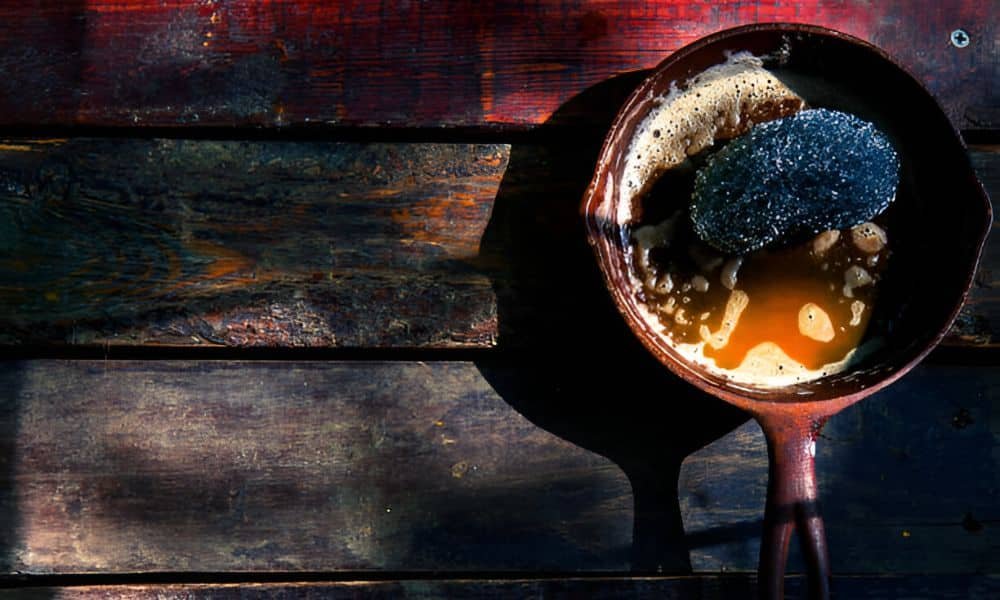I found my old cast iron pan buried in the back of a cabinet. It was rusty and rough, and I felt a little sad. That pan had cooked eggs, cornbread, even steaks. It deserved better. So I decided to save it. I learned how to clean a rusty cast iron frying pan with simple tools and a little time. The results surprised me. Now it shines and cooks like a dream.
In this guide, I’ll walk you through each step. It’s easier than you think—and worth it for any kitchen lover who wants to bring their cast iron back to life.
Why Cast Iron Rusts in the First Place
Cast iron rusts because iron reacts with water and air. Even a little moisture starts the process. That orange layer you see? That’s oxidation. It forms fast and spreads deep.
Many people make the same mistake. They rinse the pan, then leave it in the sink. Others wipe it, but don’t dry it fully. Some tuck it into a cabinet while it’s still damp.
These habits cause rust and ruin the finish. But they’re easy to fix. Cleaning the pan removes the damage and protects the metal. A clean surface cooks better, lasts longer, and looks like new.
Step-by-Step: How to Clean a Rusty Cast Iron Frying Pan
You don’t need fancy tools or special cleaners. Just a few basics from your kitchen will do the trick. Here’s how to clean a rusty cast iron frying pan, one easy step at a time.
01. Gather Your Supplies
Start with simple tools:
- Steel wool or a stiff brush
- Mild dish soap
- Warm water
- Clean cloth or paper towels
- Cooking oil (any neutral oil works)
- Foil for your oven rack
That’s it. No sprays or scrubbing pads with chemicals. Just things you already have at home.
02. Scrub Off the Rust
Put the pan in your sink. Rinse it under warm water. Use steel wool or a stiff brush to scrub the rusty spots.
Scrub in small circles. Keep going until the rust fades and the metal shows through. This takes a few minutes but works fast.
Your goal is to smooth out the rough spots and clean the surface.
03. Wash with Dish Soap

Normally, soap isn’t used on cast iron. But here, it’s okay—just once. Use a small drop of mild dish soap.
Wash the whole pan with warm water. Use your brush or sponge to remove any leftover rust or oil.
Rinse it well. No soap should stay on the surface.
04. Dry the Pan Completely
Dry it right away. Use a cloth or paper towel to soak up water. Then place the pan on your stove.
Turn the heat to low. Let the pan sit for 3–5 minutes. This step helps remove hidden moisture from tiny pores in the metal.
Once it’s dry and warm, turn off the heat.
05. Season with Oil and Bake

Now it’s time to protect your pan. Add a few drops of oil to the warm surface. Rub it over the whole pan—inside, outside, even the handle.
Wipe off any extra oil with a clean paper towel. It should look dry, not greasy.
Place the pan upside down on the middle rack of your oven. Put foil underneath to catch drips. Bake at 450°F (230°C) for one hour.
Turn off the oven and let the pan cool inside. This step locks in the seasoning and creates a natural non-stick finish.
06. That’s It—You’re Done
The pan is now clean, smooth, and ready to use. You don’t need any fancy products. Just a little care, a little heat, and a few kitchen staples.
Keep using your pan often. The more you cook with it, the better it gets.
Practical Tips from Experience

Over the years, I’ve made every mistake with cast iron. I’ve also learned what really works. These small habits make a big difference.
Use only a thin coat of oil. Wipe most of it off before baking. A thick layer turns sticky. A light one turns smooth.
Cook fatty foods at first. Bacon, sausage, or ground beef help build seasoning fast. That rich layer protects the pan and makes cleanup easier.
Store your pan with a paper towel inside. It absorbs moisture and prevents rust. Keep it in a dry spot, not under the sink or near steam.
And don’t panic if you spot a little rust. Just scrub, rinse, dry, and re-season. Fixing it early keeps the pan strong.
Common Mistakes Beginners Make (And How to Avoid Them)

I’ve made every mistake on this list. That’s how I learned. So don’t worry—I made these mistakes so you don’t have to.
One big one? Leaving water on the pan. Even a few drops can lead to rust. Always dry it right away. Heat helps finish the job.
Another is using too much oil when seasoning. A thick layer doesn’t bake in—it turns sticky. Wipe most of it off before baking.
Some people reach for strong cleaners. Don’t. Harsh chemicals or metal polish can ruin the surface. Stick with gentle tools like steel wool or a stiff brush.
And watch where you store it. Damp cabinets or tight plastic lids trap moisture. Your pan needs air. Let it breathe between uses.
Maintaining Your Cast Iron for Everyday Cooking

To stop rust, stay consistent. A few small steps after each use make a big difference. Cast iron loves routine.
Rinse your pan with warm water while it’s still hot. Use a soft brush to clear away food. Dry it right away with a clean cloth. Then warm it on the stove for a few minutes.
Once it’s dry, add a drop of oil. Rub it into the surface with a paper towel. The pan should look dry, not greasy.
Cooking often helps the surface grow stronger. The more you use it, the smoother it gets. That’s how cast iron builds its natural non-stick layer—one meal at a time.
Cooking Inspiration: From Rusty to Ready
Once your cast iron is clean, it’s time to cook. That’s where the fun begins. Each meal builds a stronger surface. Each use brings back more shine.
Start with easy dishes. Fry some eggs. Sear a steak. Toast a grilled cheese. Fatty foods help season the pan and make it better over time.
Try using your best small fry pan for eggs, too. It’s perfect for one-egg mornings or quick bites. Once you get the feel, you’ll reach for cast iron without thinking.
There’s a joy in cooking with something you saved. It’s not just a pan—it’s a story. One you get to keep writing, meal by meal.
FAQs
Can I use soap on cast iron?
Yes, but only in small amounts. Soap won’t ruin the pan if used the right way. A light wash helps during deep cleaning. Just rinse well and dry it right after.
Do I need to season after every wash?
Not every time. Just wipe it dry, then add a drop of oil. Rub it in while the pan is still warm. That keeps the surface smooth and strong.
How long does seasoning last?
Seasoning builds with use. A good layer lasts through many meals. Keep cooking, and it only gets better. Avoid soaking or scrubbing too hard to make it last longer.
Final Thoughts
Rust doesn’t mean the end. It’s just a sign your pan needs care. With a little effort, it can look—and cook—like new again.
Don’t toss it. Don’t replace it. Bring it back to life instead. That old pan still has plenty of good meals ahead.
I’ve saved pans that looked worse than yours. Now they’re part of my kitchen story. Each one carries memories—and keeps making more.

